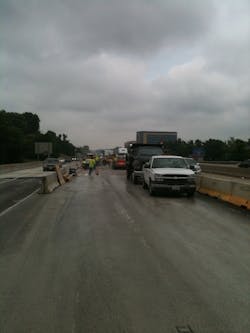The I-270 Marine Avenue overpass is an 8-lane structure, within 2 miles of the busiest interchange in Missouri and traffic count is high. Using the “voided-deck” design, the overpass of Marine Avenue suffered from cathodic activity over the years that caused premature and rapid corrosion of the reinforcing steel. The extensive corrosion of the reinforcing steel damaged the tubes and allowed excessive moisture to enter the voids, causing further damage during freeze-thaw periods. The Missouri Department of Transportation (MoDOT) determined that repairs to the voids, replacing the wearing surface and installing a new generation cathodic system would be cost-justifiable, limit traffic interruption and is faster as compared to replacing this structure.
To minimize disruption to the public, the project allowed for one full closure of a lane per day and closure of an additional lane on weekday nights for safer access to the work area. The one lane access allowed for removal of the existing wearing surface via milling, partial-depth repairs, void repairs and final surface preparation during daylight hours. The weekday, night-only placements of the new wearing surface could not start until repairs met strength, surface met MoDOT approval and cathodic grid was in-place and tested. Using traditional concretes, the schedule for each lane exceed three weeks for a total of 24 weeks. To reduce the schedule, a fast-setting/fast-strength-gain concrete with proven service in wearing-surface applications and repairs was needed.
At issue, with older generation cathodic systems, dense and fast-strength concretes have had too high of electrical resistance to allow the cathodic systems to function effectively. The new generation impressed cathodic system attaches to the reinforcing steel, via wire leads, within the existing concrete. The wire grid lays on the surface of the existing concrete prepared surface. It is then covered by the new wearing-surface concrete. Lead wires from the cathodic system grid run to a power unit where electrical current is provided. The current running through the cathodic system reduces the cathodic activity and arrests the corrosion of the reinforcing steel.
The concrete-repair contractor suggested a newer generation cement technology that they have used for overlays and repairs that MoDOT has approved for use as a potential solution for the overlay concrete. Testing revealed that the newer generation impressed system could be adjusted to accommodate higher-resistant dense concrete, so the idea was submitted to MoDOT and approved for use.
The use of Rapid Set Low-P cement—a low-permeability, corrosion-resistant, fast-setting, hydraulic cement based on advanced cement technology—allowed the concrete repair contractor to complete the work in 12 weeks, which included a two-week project shut down to move construction activities and traffic control to the opposite lanes. In addition, Low-P cement provides for a longer life cycle than with traditional concretes and in combination with the impressed cathodic system will reduce concrete problems for an expected 25 years.



